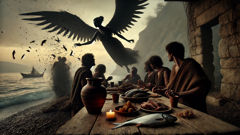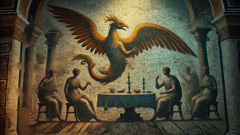Introduction
On a wind-raked promontory where the Aegean churns against limestone cliffs, the first whispers of the harpies formed like the salt spray itself: sudden, sharp, and impossible to ignore. They arrived in the old tales as interruptions—the theft of a meal, the disappearance of a laden tablecloth, the inexplicable spoiling of a banquet—and then as agents of a harsher economy: the carrying away of the guilty, the binding of shame to flesh. To the shepherds who kept watch on the islands, they were seen in fleeting silhouettes, heads thrown back in cries threaded like silver through the twilight. To those who read omens or recited lines by hearthfire, they were moral mirrors, reflecting back the consequences of greed and crime. Yet the harpies resisted a single shape. Sometimes they were ugly and winged, more beast than woman; sometimes they lingered on the edges of the world like a memory given feathers, beautiful as any siren and terrifying as any fate. The ancients themselves were unsure whether to fear them as a plague of appetite or to respect them as custodians of retribution: spirits whose hunger held a ledger and whose wings beat with the law of an older, crueller justice. This retelling follows the harpies through their earliest mentions in Hesiod and Homeric echo, through the allegories of Hellenistic poets, into the quieter corners where embers of superstition hardened into folklore. It travels with the travelers who met them and with the judges who invoked them, and it listens to the soft, relentless sound of wings against marble, as a people attempted to name what it meant for hunger and punishment to be the same thing.
Origins and Images: Harpies in Early Greek Thought
The earliest traces of the harpies in Greek imagination are fragments of an idea that refuses neat containment: creatures at once corporeal and moral, wild and juridical. Hesiod and early epic murmurs leave them at the edges—names and gestures rather than full portraits—and these murmurs do more than hint at physicality; they carry a cultural logic. The harpies are at first the personification of a force that consumes: storm, famine, the sudden erasure of abundance. But the Greeks, who delighted in giving mind to forces, translated that erasure into beings whose appetites could be held responsible. In Homeric shadows and local mythic traditions, the harpies do not simply take food; they hold memory of retribution.

So begin their images: the bird-woman with talons, the face of a woman set in a raptor's neck, a rustle of feathers where speech might be expected. Poets paint, historians narrate, and vase-painters etch their versions onto clay—some haunted, others almost comic. On black-figure amphorae their wings are rendered with a practiced economy, as if the painter meant to remind the viewer of a known vocabulary: the hybrid body that signals a world where boundaries between nature and law blur. The ancients did not only associate harpies with appetite; they associated them with the Erinyes, with the nether logic of vengeance. To be taken by a harpy was to enter a corridor where the living world and the punitive designs of gods met. The harpy’s theft of a meal becomes, in many tales, the preface to a grander justice—the delivery of a soul or the exposure of a crime. Some local stories told of harpies as a scourge sent by annoyed deities: a goddess affronted by human hubris might loosen winged spirits to settle accounts. The economy of these tales is precise: appetite as an instrument for punishment. The surface crime—stolen bread, a missing piece of roast—masks a deeper imbalance, a moral lapse that demands correction.
At the center of this origin narrative sits a paradox: harpies act like thieves, but their thefts are often righted by cosmic law. They are both predators and auditors. When a seafaring captain bragged at the wine-damp pier about his conquests, a harpy might take a plate from his hands as if to remind him that arrogance invites losses. When a magistrate sold a verdict for coin, harpies arrive in the night to steal his food and his composure, a nocturnal indictment. The mythic function in these stories is less about terror and more about accountability dressed in feathers. Their grotesque and hybrid forms, too, perform a function in the imagination: by combining human face and animal hunger, poets could sketch a warning that is at once practical and poetic. The image is memorable because it binds empathy with revulsion. In the mosaic of the mythic world, the harpy stands against neat morals; she is a reminder that even petty thefts can be signs of rotting civic virtue.
But origin-stories are not static. As the Greek world expanded—through trade, colonization, and contact with foreign pantheons—so did the visual and narrative repertoire available to those who told harpy tales. Contact with Near Eastern motifs, where winged figures appear in a hundred functional roles, may have deepened or altered the Greeks’ conception. In some recastings, harpies take on ritualized attributes: they are attendants to a chthonic goddess; they are psychopomps who ferry the souls of those who died under certain conditions. This fluidity allowed local cults and poets to claim the harpies as they needed: sometimes fearsome, sometimes ambivalent, sometimes protective in their fury. It is instructive that the same basic figure serves such rhetoric: an agent of chaos made into an instrument of order, a winged adversary who keeps civic or divine balance.
Consider the way storytellers used harpies in civic pedagogy. A magistrate’s misdeed provided fertile ground for a tale in which the harpies’ theft precipitates exposure and disgrace. Children raised on these stories learned early that appetite has a mirror: community, commerce, and the gods watch. The harpies thus join the chorus of mythic figures who enforce norms indirectly—less through moralizing sermons and more through the terrifying plausibility of a sudden, uncanny reckoning. To that end, the physical grotesquerie of the harpy’s form becomes moral shorthand. Artists and writers, aware of the dramatic potency, urged their audiences to imagine the wings beating in the corners of banquet halls, the feathers ruffling above a council chamber when a verdict slips or a bribe is passed. It was an image meant to stick, to appear suddenly in the mind's eye when one was tempted toward small thefts or larger betrayals.
Yet classical sources also complicate this punitive picture with stories that grant the harpies personalities and voices. When poets give them speech, the harpies express scorn, sorrow, or even weariness. This humanizing gesture shifts them from flat instruments of vengeance to characters with moral perspectives of their own. The consequence is that the map between crime and retribution is no longer simple: harpies do not merely respond to a ledger of wrongs; they relate to context, history, and a woven sense of honor. In one notable cluster of tales, the harpies are agents of divine memory, carrying away a man's meals only after he has neglected a sacred promise or desecrated a household shrine. The theft thus becomes less an act of random malice and more a formal act of record-keeping—the gods’ ledger made flesh and feather. To be harried is to be reminded that the world keeps accounts even when human systems fail.
Finally, the early image of the harpy shows the Greeks wrestling with the frontier between nature and custom. When wind strips a ship of its sails or when disease sweeps through a flock, the loss is sometimes narrated as the work of a creature beyond law. Yet the harpy's law is also ancient law—older than democratic councils and written codes. In their winged silence, harpies preserve a memory of a time when consequence was immediate and embodied. This double belonging—to wild appetite and to the enforcement of cosmic order—makes them uniquely Greek in a way: they are local, ecological, poetic, juridical. They remind a people that the world makes moral judgements in more ways than one: through judges in robes, yes, but also through the sudden, irreducible interventions of the natural and the numinous.
(An image: a midsection illustration of a harpy descending on a coastal feast, her shadow splitting the light, fish bones and bread crusts scattered below.)
Stories, Functions, and the Slow Unraveling of Fear
The harpies’ narratives, once firmly rooted in the language of public correction, spread into a variety of literary and oral roles that allowed storytellers to pry into quieter human anxieties. Aesop-like parables, satirical verses, and local legends took what had been a grand, ambiguous force of retribution and folded it into everyday lessons. In these forms, the harpy could be comic—an absurd intruder at a poor man's supper—or chillingly intimate: the sound on a widow's roof at midnight, the phantom that robs a cheating spouse of peace. The variety of functions reveals a cultural willingness to let the same mythic figure serve multiple psychological needs: to warn, to punish, to explain loss, and sometimes to console by giving a shape to misfortune.

When the Roman world adopted Greek mythology, many harpy images traveled westward, altered by translation and cultural demand. Roman poets and satirists found in the harpy a convenient figure for social commentary. Satire loved the harpy because she so easily stood for ravenous appetite—the appetite of the wealthy, the corrupt, the powerful. The satirist’s harpy is a searing image: greed given wings. Yet among educated circles the harpy could also be a symbol of fate; in philosophical treatments, her theft resembled the Stoic notion that external fortunes are ephemeral and sometimes snatched from under mortal plans. This shifting symbolic life meant the harpy could be a cautionary emblem in a public address and a private metaphor in a letter between lovers. Even in late antiquity, the hybrid form endured in mosaics and sculptures, reminders that the image resonated even when the literal belief began to fade.
But as belief softened, other voices took up the harpy’s story. Christian interpretive frameworks, for instance, reframed many pagan monsters as demons or moral allegories. Where once a harpy enacted cosmic justice, now she might be read as a tempter, a creature that leads souls astray. This re-casting speaks to the long adaptability of mythic forms: they bend to theological needs and ethical narratives of each era. Medieval compilers, drawing on late antique sources, preserved harpy stories in bestiaries and chronicles, smoothing edges and sometimes adding gruesome detail. Their harpies were less ambiguous: symbols of vice, embodiments of divine retribution, or portents of disaster.
Despite these transformations, the harpy's narrative power lay in the details. Many preserved tales hinge on small human acts: an oath broken at a shrine, a widow's right taken by a wealthy cousin, a priest who sells sacred oil. The harpies, when they come, transform these private wrongs into public spectacle. A single stolen loaf becomes a scandal because it is the sign of a pattern; a missing cup at a wedding banquet becomes the foreshadowing of familial ruin. In myth, details matter because they serve as the connective tissue between the individual's moral life and communal adjudication. Harpies perform the uncomfortable service of translating what might be a silent, internal transgression into an audible, visible punishment. They are both message and messenger.
The stories also record a variety of reactions to the harpies. Some communities ritualized placation: offerings made at certain times in hopes of appeasing winged spirits. Others learned to tell the story precisely to children as if to inoculate them against petty crimes. There are accounts of oaths sworn beneath the same gaze that had once inspired fear, as if the ritualized act of remembering neutralized the threat. And, in quieter corners, some poets and storytellers imagined reconciliation: harpies who relent when the wrong is righted, who return stolen goods with a mocking flourish and a lesson. These narratives reveal an important moral economy: punishment is not always endless; sometimes the harpy’s theft is a restorative act designed to compel restitution rather than eternal ruin.
We find also more intimate portrayals of harpies when myth enters family lore. A father might tell a harpy story to a son who contemplates bribery; a grandmother might use the same tale to explain why a neighbor's fortune mysteriously crumbled. In these retellings, the harpy functions as a communal conscience, an heirloom of warning that tests the boundaries of revenge and mercy. The balance between terror and pedagogy is delicate: narrators with a taste for ambiguity might let the harpy hover in the final line, leaving listeners with a shiver rather than a solution. The ambiguity suits the figure; the harpy resists being domesticated.
As the modern age approaches, harpies slide further from active belief into the symbolic. Scholars comb through vase shards and fragments of epic to assemble a genealogy of the figure; novelists and poets take the harpy into new moral economies. In contemporary retellings, the harpy can be reclaimed as a figure of resistance—especially in feminist readings that see the bird-woman as a punished female appetite or as a creature marginalized for being neither fully woman nor fully beast. There is something compelling about this reclamation: the same image that once policed social appetite can become, in another hand, a critique of the social order that polices women’s bodies and desires. The harpy, in this light, is both haunting and emancipatory: a witness to the price women pay for transgressing domestic expectation, and a symbol for the appetite that refuses to be contained.
Taken together, the stories show how a mythic figure migrates across genre and era while preserving an essential concern: the negotiation between appetite and order. Whether as a punishing force from an angry goddess, a satiric emblem of greed, or an object of sympathetic reinterpretation, the harpy remains stubbornly relevant because appetite—both literal and metaphorical—remains a central human problem. The narratives invite us to ask difficult questions: when is punishment justice, and when is it cruelty? When is appetite a moral failing, and when is it simply an aspect of being alive? The harpy's wing, beating in the margins of the story, demands that we hold both possibilities at once.
(An image: a late-antique mosaic fragment showing a harpy hovering over a banquet, mosaic tesserae glinting in uneven golds and blues.)
Conclusion
The harpies of Greek myth resist being reduced to a single moral. They begin as creatures of appetite and end as symbols shaped by centuries of retelling—judicial tools in one epoch, satirical devices in another, and in many modern readings, figures for the complicated rights and wrongs of desire. Yet their endurance reveals something particular about myth: it thrives in ambiguity. A harpy can both snatch a meal and compel a confession; she can both haunt a table and remind an entire community that particular acts matter. Across the Aegean, where salt and wind rewrite edges every season, the harpy’s wing remains a useful image for the volatility of fortune. She teaches that the boundary between private appetite and public accountability is porous, and that stories—if told well—can both frighten and instruct. To summon the harpy is to remember that laws are not only carved in stone or inked in scrolls; laws live in communities and take strange, feathered shapes when those communities sigh with grievance. Perhaps the harpy’s most lasting lesson is this: vigilance and empathy must travel together. Hunger, unchecked, can become greed; punishment, unmeasured, can become cruelty; and the right story—precise, unsparing, humane—can be the tool that tiptoes between the two, naming wrongs without killing hope. In the end, listening to the harpy's cry is less about fearing wings than about understanding what, in our human world, we choose to protect and what we are willing to give back.













